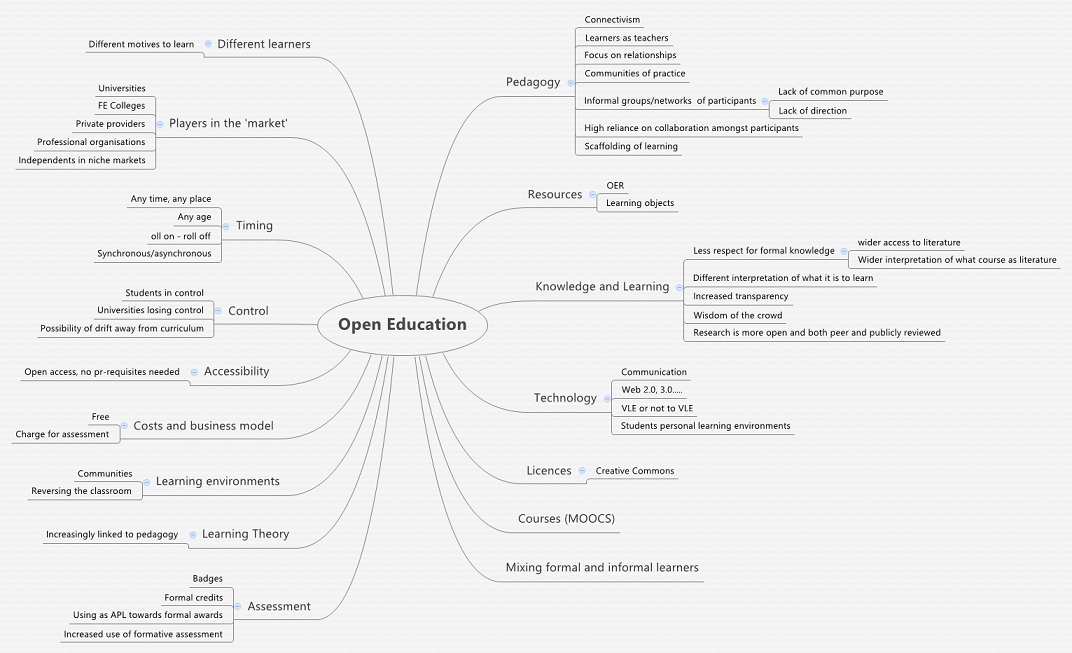I feel that this activity is a little confused in that it asks us to consider issues to do with OERs and yet many of the suggested readings are about Open Education and that is not synonymous with Open Educational Resources. This activity is claimed to build in a previous activity in which we identified three priorities for Open Education. In the earlier activity I identified pedagogy, accessibility and sustainability as three key issues for applying concepts of Open Education in an HE environment. These will be used here.
Pedagogy:
Comment based on; Attwell, G. & Pumilia, P.M. (2007) The New Pedagogy of Open Content: Bringing Together Production, Knowledge, Development, and Learning. Data Science Journal, 6, 211- 219
Attwell and Pumilia suggest that one of the biggest threats of the open content movement is the possible commodification of knowledge; the tendency for knowledge to be thought of as a product or set of products that can be bought or sold. I found this very interesting and thought provoking, largely because the predominant philosophy is that openness increases accessibility, breaks down barriers, etc etc. The authors move on to discuss the juxtaposition of the move towards a tightening of copyright laws whilst at the same time we are witnessing a proliferation of freely available Open resources. They then consider how quality of such open resources can be assured (hence the connection to pedagogy). Perhaps we might see a move towards a rating system of OERs, whereby those created by ‘professionals’ are valued more highly?
Accessibility:
Comment based on; Caswell, T. et al., (2008) Open educational resources: Enabling universal education. International Review of Research in Open and Distance Learning, 9(1), 1–4.
Caswell compares traditional distance learning with the new era of open resources whereby digital technologies have led to an elimination of distribution costs. This, in turn has led to the role of distance education shifting towards a tool for social transformation, not merely an alternative to classroom teaching. Once the capacity to offer free educational materials has been achieved it can even be considered a moral obligation to do so, in order to satisfy the basic human right to education. This paper does not consider the practical aspects of facilitating accessibility in terms of access to broadband, necessary software, etc.
Sustainability:
Comment based on: Downes, Stephen (2007), 'Models for sustainable open educational resources', Interdisciplinary Journal of Knowledge and Learning Objects, vol. 3. Available from: http://ijklo.org/Volume3/IJKLOv3p029-044Downes.pdf
The widening access as a result of lowered costs brings with it a problem; sustainability. Downes examines sustainability from the perspective of three models; funding, technology and content. He also suggests that we need to consider OERs as part of a bigger context to include volunteers and incentives, community and partnerships, etc. Downes suggests that the definition of “Open” must include an assumption of “free”, and that free should apply not only to free access, but also freedom to copy, modify, redistribute. But such notion of free and accompanying freedoms do not mean that the production and or maintenance of such resources are cost free. The per-unit cost can be reduced by increasing the number of downloads or users but this does not reduce the cost of production. Other costs relate to investments in technology, organization and policy. Notions of sustainability may not relate to covering costs or making money but also to achieving some particular, wider objective. In such cases the deadweight cost may be carried due to the wider potential benefits.
In terms of funding models, a number are identified; endowment, membership, donations, conversion, contribution, sponsorship, institutional, government, partnership and exchange. I was not familiar with all of these models, so found this aspect of the paper very interesting, and useful.
